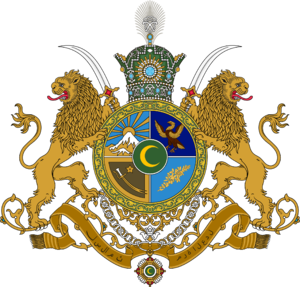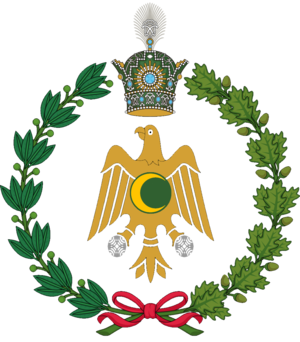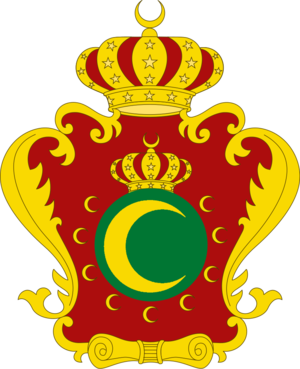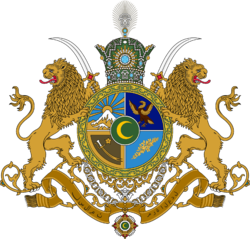Coat of arms of Çakaristan
| Coat of arms of Çakaristan | |
 | |
| Details | |
|---|---|
| Armiger | Çakar Empire |
| Adopted | 1711 AN |
| Motto |
صلح ثمره عدالت است Peace is the fruit of justice |
| Jonas Windsor designer Gustaaf Vermeylen originator | |
The Coat of arms of Çakaristan is the official heraldic symbol of the Çakar Empire. It was adopted in 1711 AN, seven years after the collapse of the Great Apollonian Empire. This coat of arms was one of the elements introduced as part of the Second Çakar revolution.
The Çakari Congress could not agree on the design for a long time. The states all wanted a place on the shield, this became more difficult with expansion of the empire. The decision was entrusted to the Shahanshah and his choice was adopted.
It replaces the earlier Shahanshah emblem, which acted as a temporary coat of arms pending the acceptance of a permanent one. Hereafter, the emblem was retained as the emblem for the Shahanshah.
Description
The shield consists of the heraldic symbols:
- In the centre: the golden crescent moon on a Çakar green background;
- Top left: Emblem of Kendall: Jabal al-Mada', that is the dawn-lit mountain, with a rising sun;
- Top right: A derivative of the Arbor coat of arms with the golden Arbor eagle on a dark blue background;
- Bottom right: The symbol of Haritdesh: the golden oak branch on a light blue background;
- Bottom left: The Dhulfaqar which represents the just division between right and wrong. The important role a just government as envisaged in the Akbar Constitution.
The edge is decorated with lotus pattern in gold.
On the upper side of the coat of arms is the Shahanshah crown and the collar of the Order of Çakar under the shield. The lions with scimitars are the supporters. The motto written on a ribbon: “صلح ثمره عدالت است” (Peace is the fruit of justice).
Shahanshah Emblem
| Shahanshah Emblem | |
 | |
| Details | |
|---|---|
| Armiger | Shahanshah of Çakaristan |
| Adopted | 1704 AN |


The Shahanshah emblem is taken from the coat of arms of the Emirate of Arbor. On that coat of arms, this emblem was placed in gold on a blue roundel, surrounded by a chain and crowned with a royal crown. The emblem is a detailed enlargement of this central piece and elevated to the symbol of the Shahanshah. The elements of this emblem:
- The eagle in the middle can be traced back to 1670 AN. Per Imperial Decree 1193, the Shirerithian noble title Duke of Brandenburg was bestowed by Kaiser Ayreon IV on Arkadius Frederik Gustavus des Vinandy, later known as Mahmud bin Alsalam. That city, which became the capital of West Amokolia and later the Frankish Empire, had the eagle as its symbol. It was also used on the flag and coat of arms of the Frankish Empire. After its fall, the eagle became the symbol of the Emirate of Arbor.
- The heart of the cresent moon, also known as the seal of Çakaristan. This symbol appears not only on the coat of arms of Arbor but also as a roundel on the Emblem of Çakaristan. The colours of the heart have been adapted to the new colours of the flag. The crescent moon is associated with Craitism, the main religion in Çakaristan.
- The eagle is surrounded by a wreath of laurel and oak branches. In addition to the heraldic meanings - The laurel branch represents victory and virtue; and the oak branch represents power and authority - the branches stand for specific meanings:
- The laurel branch is one of the insignia for members of the Order of the Holy Lakes, especially members of the princely and royal classes. The current Shahanshah, Jaaguzan, is Prince among the Lakes by birthright.
- The oak branch is a reference to the Sessile oak (Quercus petraea), the national tree of Amokolia. This species of oak tree does not occur in Çakaristan; other species do occur, often with ovoid, toothed leaves. This is different from the Sessile oak that has lobed leaves.
- The crown is the crown of the Shahanshah. It is more elaborate than the representation on the roundel of Arbor. The extra feathers on the crown symbolise the grandeur of the Çakari Shahanshah. A different crown was used until 1712 AN, this is also called the second crown.
The Shahanshah emblem was used as the coat of arms of Çakaristan between 1704 and 1711 AN until the introduction of the new coat of arms. Nowadays, the emblem is used only for the Shahanshah.
Historic Emblem
| Emblem of Çakaristan | |
 | |
| Details | |
|---|---|
| Armiger | Çakar Empire |
| Adopted | 1687 AN |
Between 1687 and 1704 AN another emblem was used as the coat of arms. It was called: "Emblem of Çakaristan". It consists of a golden cresent moon, resting on a green background. This part of the emblem was also used as a separate Seal of Çakaristan. This is crowned with a small golden diadem.
This crowned seal stands in the centre on a red mantle, surrounded by nine golden cresent moons. The mantle is decorated with golden ornaments. All this is crested with a crown of a golden diadem with five hoops set of stars and carrying the cresent moon.
See also
| ||||||||||||||||||||||||||||||||||||||||||||||||||||||||||||||||||
